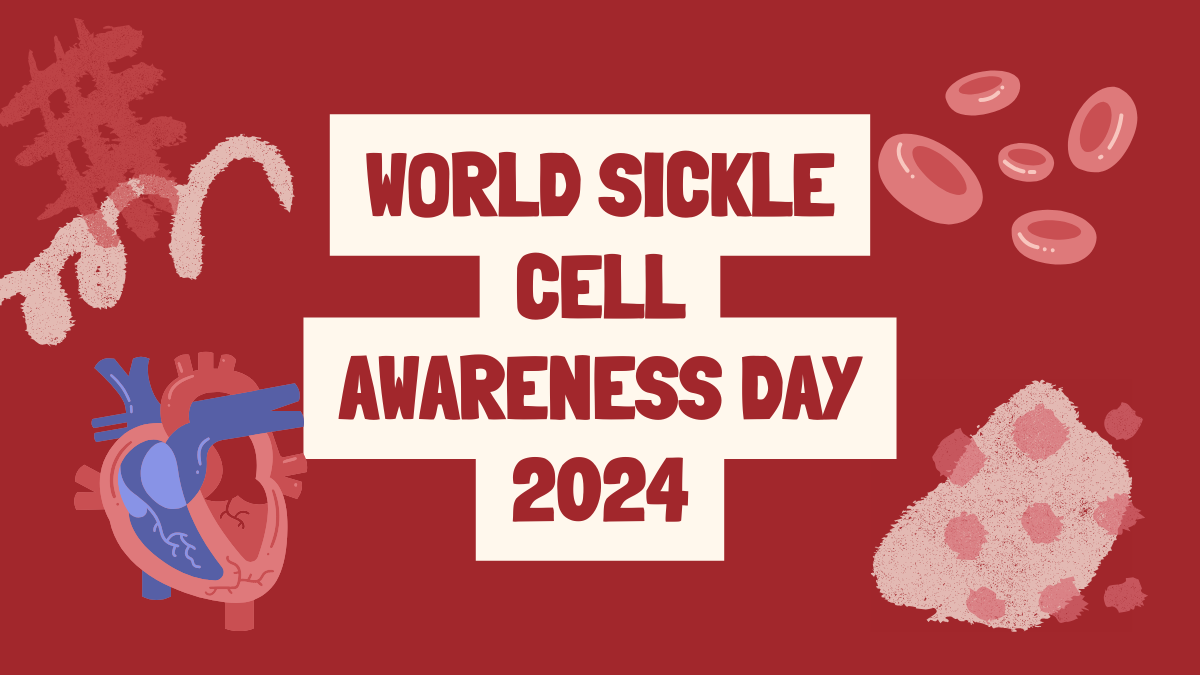Table of Contents
On the 19th of June in the current year, the global community unites to observe World Sickle Cell Awareness Day, a pivotal public event aimed at raising consciousness about this debilitating condition. Annually, on the 19th of June, individuals and organizations across the globe commemorate World Sickle Cell Day, a solemn occasion dedicated to heightening awareness about the human sickle cell disease. This day was designated by the United Nations as a means to shed light on the disease, its underlying causes, the necessary care and measures that must be undertaken, and the appropriate treatment protocols for those afflicted by this condition.
World Sickle Cell Awareness Day 2024
Sickle cell disease is a hereditary blood disorder characterized by the presence of sickle-shaped red blood cells, which can cluster together, impeding the flow of blood and oxygen to various parts of the body. This condition is transmitted genetically from one generation to the next.
According to the US Centers for Disease Control and Prevention (CDC), individuals living with sickle cell disease may experience a range of debilitating symptoms, including chronic pain, anemia, increased susceptibility to infections, and other severe health complications that necessitate prompt medical attention. Individuals experiencing unexplained fever, severe pain in the abdomen, chest, bones, or joints, swelling in the hands or feet, abdominal swelling (particularly if the area is tender to the touch), pale skin or nail beds, or a yellowish tint to the skin or whites of the eyes should seek immediate medical consultation for early detection and emergency treatment of the disease.
World Sickle Cell Awareness Week 2024: Theme
The World Sickle Cell Awareness Day 2024 carries the theme “Hope Through Progress: Advancing Sickle Cell Care Globally,” underscoring the global commitment to fostering advancements in the treatment and management of this debilitating condition. This annual observance serves as a platform to raise awareness about the available therapeutic options and to galvanize coordinated efforts towards achieving effective control of sickle cell disease across nations.
Sickle cell disease is a hereditary form of anemia characterized by a deficiency in the red blood cells’ ability to transport adequate levels of oxygen throughout the body. While red blood cells typically exhibit a spherical shape, individuals affected by this condition have red blood cells that assume a distinct crescent or sickle-like shape. This abnormal morphology impedes the cells’ ability to circulate freely, as they frequently become entrapped within the narrow confines of small blood vessels, obstructing the flow of blood and oxygen to various parts of the body.
Important Days in June 2024: List of National & International Days
World Sickle Cell Awareness Week 2024: History
• The United Nations General Assembly recognized the gravity of sickle cell disease and declared World Sickle Cell Day in 2008, with the aim of raising global awareness about this debilitating condition. They shed light on the immense physical suffering and emotional turmoil endured by individuals afflicted with this disease.
• Consequently, the inaugural observance of World Sickle Cell Day took place on June 19, 2009, marking a significant milestone in the global campaign against this illness. Sickle cell disease has transcended geographical boundaries, gradually evolving into a hereditary and genetic condition with a widespread impact.
• With a substantial portion of the global population now affected by this disease, it has become imperative to empower patients through increased knowledge, access to effective care, and appropriate treatment options.
• Furthermore, accurate diagnosis and early intervention play a crucial role in facilitating better management and treatment of this condition. In addition to the United Nations’ efforts, the World Health Organization (WHO) now offers various initiatives aimed at providing more humane treatment options for individuals living with sickle cell disease.
• Official data and sources reveal the staggering reality that more than 1000 newborns succumb to this condition before reaching the age of five. The disease has spread rapidly across Africa and the United States, affecting an estimated 90,000 to 100,000 individuals.
• Moreover, sickle cell anemia has a significant presence in countries such as India, Saudi Arabia, Turkey, the Arabian Peninsula, Brazil, Suriname, Guyana, Southern Italy, Greece, and numerous other nations worldwide.
World Sickle Cell Awareness Day: Significance
• The abnormal sickle-like shape of red blood cells (RBCs) in sickle cell disease makes it challenging for them to circulate smoothly throughout the body.
• Sickle cell disease is a hereditary or genetic condition that cannot be transmitted through contact or contagion.
• Currently, there is no definitive cure available for sickle cell anemia, but early detection and prompt treatment of patients are considered among the most effective approaches to manage the condition.
• In sickle cell anemia, the distorted sickle shape of RBCs impedes their ability to flow freely within the body, whereas in iron-deficiency anemia, there is a deficit in the number of RBCs.
• Ongoing efforts are being made to raise awareness about sickle cell anemia as a significant global health concern and to educate people about effective strategies to combat this condition.
• Awareness campaigns play a crucial role in dispelling myths and misconceptions surrounding sickle cell disease, while also providing necessary support and resources to individuals diagnosed with the condition.




 GA Capsule for SBI Clerk Mains 2025, Dow...
GA Capsule for SBI Clerk Mains 2025, Dow...
 The Hindu Review October 2022: Download ...
The Hindu Review October 2022: Download ...
 Seating Arrangement Questions for IBPS R...
Seating Arrangement Questions for IBPS R...


